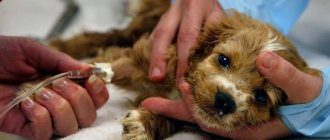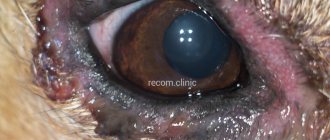Brucellosis is an infectious disease. Its main carriers are rodents, fur-bearing animals, pigs, large and small cattle. Domestic dogs rarely suffer from brucellosis. The risk group includes mature individuals living in rural areas and hunting dogs.
Sick animals give birth to weak and non-viable offspring. Inability to bear offspring and infertility are often observed. Brucellosis bacteria can prepare your pet's body for the development of other dangerous diseases.
What is brucellosis in dogs?
Brucellosis is a disease caused by the gram-negative non-motile bacteria Brucella. There are 6 types of these parasites, but dogs are only affected by one of them: Brucella Canis.
ATTENTION! The strains are resistant to external influences. They are able to continue to live in feces, urine and other biomaterials for up to 6 months. They are not afraid of the cold. You can kill them using high temperatures and disinfection.
The incubation period for brucellosis in dogs ranges from 1 week to 1 month. The bacterium is most active in the first six months after infection. It accumulates and multiplies in the pet’s lymph nodes and blood. The first organs to be affected by this parasite are the liver, spleen and bone marrow. The disease deals its main blow to the genitourinary system.
Pathogenesis (origin) of brucellosis
The causative agent of the infection is a bacterial microorganism belonging to the genus Brucella. The genus contains a small number of microorganisms, but they are all genetically isolated. The bacterium that causes brucellosis in dogs is a gram-negative rod, nonmotile. Brucellosis bacilli are not able to encapsulate and form spores.
Several species of Brucella can cause disease in dogs, but Brucella canis is most often involved. This species can provoke the development of brucellosis in humans, causing a characteristic clinical picture - headaches, joint inflammation, fever.
Brucella is not resistant to environmental factors. So, when heated to 60 degrees, microorganisms die within half an hour, at a temperature of 80 - within 5 minutes. Heat treatment at temperatures above 100 degrees causes the death of pathogenic microorganisms immediately. In addition, Brucella is sensitive to phenols, alcohols, formalin and other disinfectants.
It is important to note that in feces, urine and other biological materials, the infectious agent can remain active at low temperatures for 4-5 months. Ultraviolet rays kill Brucella instantly. The incubation period ranges from 7 days to 4 weeks. Therefore, it is difficult to determine when the dog was infected and where it picked up the infection.
Routes of infection
All dogs can get brucellosis. It does not matter breed, gender, or age. It has been noted that females are most susceptible during pregnancy. Pathogenic microorganisms enter the body of a susceptible host in several ways:
- Through the respiratory system;
- through nutritional means – when eating contaminated feed, meat or meat products;
- sexually - during mating of an infected dog and a healthy one;
- by contact - through damaged or undamaged skin.
The pathogenic feature of microorganisms that cause brucellosis in dogs is the ability to produce specific enzymatic substances - hyaluronidase and neuraminidase, which destroy epithelial cells and allow them to easily penetrate the skin or mucous membranes.
The most common route of infection is contact. Having penetrated through destroyed epithelial cells, Brucella enters the systemic bloodstream, spreading through the dog’s lymphatic system, reaching nearby regional lymph nodes.
Course of the disease
Already in the first hours after entering the dog’s body, Brucella is susceptible to attacks by macrophages and neutrophils. The peculiarity of microorganisms is that they can not only actively resist the cells of the animal’s immune system, but are also able to penetrate inside them. Located inside phagocytes, brucella are protected from antimicrobial drugs and other drugs used to destroy microorganisms. This poses a risk of infection and further treatment.
Located inside the macrophage, Brucella gradually disrupts the metabolic processes in the cell. As a result of the actions of the pathogenic agent, the phagocyte dies, brucella goes into the open space and tries to be captured again by a macrophage or neutrophil. The spread of Brucella in a dog's body is not limited to the lymph nodes. The causative agent of the infection actively affects organs covered with parenchyma - liver structures, spleen, bone marrow, testicles, appendages, tissue structures of the uterus in females.
The activity of infection inside the dog’s body leads to the development of multiple inflammatory processes characterized by a chronic course, with regular phases of exacerbation. The long-term presence of Brucella in the pet’s body provokes the development of dystrophic processes in the parenchyma of the affected organs, sclerotic processes and fibrin deposits.
How can people become infected with the disease?
Brucella Canis bacteria are found in biological fluids:
- saliva;
- mucous membranes of the nose and eyes;
- sperm;
- amniotic fluid;
- milk.
From this information we can conclude that a dog can become infected with brucellosis in one of the following ways:
- When mating.
- Bacteria can penetrate the placenta, which means puppies can become infected from their mother in the womb.
- During childbirth. Cubs can contract an infection while passing through the birth canal.
- When breastfed.
- Airborne (rare).
- Through saliva or blood.
- Consumption of contaminated products.
- When licking discharge from the genitourinary organs.
Pathogen transmission
B.canis is shed in semen, with the highest concentrations in semen observed during the first six months after infection. Other sources of pathogen include the fetus, placenta, amniotic fluid, vaginal discharge after abortion or stillbirth (for several weeks), and normal vaginal discharge, especially during estrus. Brucella can be contained in urine, milk, small amounts of saliva, discharge from the nose and eyes, and feces. In most cases, infection occurs through sexual contact or through contact with an aborted fetus and its membranes. Puppies can become infected in utero and also through milk. Other potential routes of infection include blood transfusions and contaminated syringes.
Brucella can be transmitted mechanically. It can persist for several months in water, aborted fetuses, equipment and clothing; withstands drying, especially in organic substrates. Low temperatures and lack of solar radiation also contribute to the preservation of Brucella.
The disease is zoonotic, i.e. People can also become infected with brucellosis, although this is rare.
Symptoms
The first signs of the disease appear a couple of weeks after infection. It is worth noting that brucellosis is a poorly studied area, and its symptoms are similar to other diseases.
The first harbingers of trouble:
- decreased activity;
- loss of appetite;
- enlargement of subcutaneous lymph nodes;
- temperature increase;
- weight loss;
- in rare cases, damage to the musculoskeletal system: arthritis, unsteady gait or lameness.
Important! Symptoms also differ by gender.
Girls experience:
- delayed estrus;
- greenish-brown discharge;
- inflammatory process in the genital area;
- after childbirth, delayed removal of the placenta;
- miscarriage at 6–7 weeks;
- the birth of dead offspring or non-viable cubs.
In boys, the following symptoms appear as a result of bacterial attack:
- loss of libido;
- immature sperm is produced;
- scrotal dermatitis;
- prostatitis;
- in the chronic form, the testicles become wrinkled;
- testicular atrophy;
- with recent infection, the scrotum or testicle becomes enlarged.
Symptoms of canine brucellosis
Brucellosis in dogs is characterized by a chronic course, often occurring in a hidden, latent form. After penetration into the body, brucella are transported through the bloodstream to the organs of the reticuloendothelial system, in which new foci of infection are formed with repeated release of bacteria into the blood, which becomes the cause of a general toxic infectious syndrome. From the bloodstream, Brucella enters the liver and central nervous system, and the musculoskeletal and genitourinary systems are most often affected. The immune reactions that develop during brucellosis in dogs do not provide sufficient bacteriological cleansing of the body. In addition, Brucella can transform into L-forms, which have minimal effects on immunocompetent cellular structures and can be resistant to antibacterial drugs.
With brucellosis in males, the organs of the reproductive system are most often affected, which can manifest as orchitis, epidymitis, which, as the disease progresses, lead to atrophy of the testes. In females, pathological discharge from the genitals, catarrhal, catarrhal-croupous endometritis is noted. In pregnant bitches in the seventh to tenth week, spontaneous abortions (miscarriages), the birth of still, non-viable puppies, and delayed placenta are possible.
Other symptoms and pathological manifestations in dogs are:
- decreased physical activity;
- deterioration of general condition;
- remitting fever;
- enlargement of regional lymph nodes;
- digestive disorders, loss of appetite;
- disturbances in the functioning of the liver (nephritis), liver.
When the musculoskeletal system is affected by Brucella, dogs are diagnosed with arthritis, unsteady gait, and partial lameness.
Is it transmitted to humans or not?
IMPORTANT! Brucellosis is a zoonotic infectious disease. A person can become infected not only from his four-legged friend, but also by consuming meat and milk from infected livestock.
The bacterium Brucella Canis infects the following systems in humans:
- sexual;
- nervous;
- cardiovascular;
- musculoskeletal system.
Brucellosis can trigger the development of other diseases. For example, arthritis, meningitis or encephalitis. It may cause infertility.
The danger of the disease is that it is incurable.
ATTENTION! At risk are people who interact with dog blood and secretions. This category includes breeders and veterinarians. The likelihood that an ordinary owner will become infected with brucellosis from a pet is minimal.
It is best to examine newborn puppies wearing disposable gloves. Afterwards, be sure to wash your hands with soap.
A sick animal poses a particular danger to people with weak immune systems. As a rule, this condition occurs after a long illness.
Preventive measures
Despite the fact that veterinarians have a wide variety of vaccines used to prevent brucellosis in humans and farm animals, such a vaccine has not been invented for dogs.
For preventive purposes, all dogs at risk should be tested for infection:
- when keeping several dogs;
- with an unspecified medical history;
- with problems of the genitourinary system;
- with miscarriage and infertility.
Before mating, animals of both sexes are subject to mandatory testing for brucellosis. For breeding purposes, it is better to refuse animals from areas unfavorable for this infection.
Prevention in nurseries
Preventive measures in nurseries are based on compliance with sanitary and veterinary standards to avoid the introduction of the brucellosis pathogen from the outside:
“Newcomers” are quarantined for a month and examined for brucellosis. Not earlier than after receiving negative tests for RBC and RA, they can be in contact with other dogs. If a female dog has an abortion in a kennel, the fetus must be tested for Brucella. It is necessary to exclude feeding pets with raw meat, dairy products, and liver from farm animals kept in areas unfavorable for brucellosis. If a pathogen is detected in the nursery, the following measures are taken:
- Quarantine is imposed.
- Sick, probably infected, animals of low value are euthanized. The rest are subject to mandatory monthly screening for brucellosis.
In premises for keeping dogs, disinfection is carried out using solutions:
- freshly slaked lime (20% suspension);
- sodium hydroxide (2%);
- formaldehyde (2%);
- calcium hydrochloride (with an active chlorine content of at least 3%).
Deratization and disinfestation are also carried out, feces are disinfected and destroyed. People caring for sick pets need to remember the increased risk of contracting brucellosis. All personal prevention and sanitation measures should be strictly observed to protect yourself from infection.
Analysis and diagnosis of the disease
To determine the fact of brucellosis, differential diagnosis is used. With its help, the doctor excludes other diseases with similar symptoms:
- toxoplasmosis;
- leptospirosis;
- listeriosis;
- chlamydia;
- salmonellosis;
- carnivore plague.
ATTENTION! Brucellosis can be detected in a dog’s blood 8–12 weeks after infection.
Standard diagnostics involves taking tests:
- Swab for bacterial culture.
- Serological testing.
- PCR study.
- Blood test for antibodies.
If the results obtained are unclear, a repeat examination is prescribed. It is carried out after 1 month.
Manifestations of brucellosis in humans
Symptoms of the disease vary widely among people and can be difficult to diagnose. To simplify the classification, experts have identified the stages of compensation:
- The compensated stage is called the formation of primary latent infection. Symptoms are not observed or are minimized and have a blurred picture.
- With decompensation, acute septic forms appear. Fever occurs with significant temperature fluctuations (37−40°C). There is an increase in lymph nodes, spleen and liver. There are no foci of contamination.
- During subcompensation, activation of the reserve functions of the immune system can be observed. A chronic metastatic process is formed with the formation of multiple foci of contamination. Symptoms of general intoxication appear, and multiple organ damage occurs.
- During the compensatory stage, recovery is stated, but post-infectious symptoms may remain. Individual manifestations persist for two to three weeks.
With multiple organ lesions, the musculoskeletal system suffers. Bone tissue grows in large joints, which is accompanied by pain. After some time, swelling and restrictions in the mobility of the bone joint occur, but there is no hyperemia at the site of the lesion. Fibrositis of soft tissues may occur in the back, forearm, and lower leg. The lesions can reach a size of 4 cm , they are dense and painful to the touch. Possible myositis manifests itself as dull muscle pain for long periods of time and may be accompanied by hardening.
With lesions of the peripheral and central nervous system, neuritis, sclerositis, as well as symptoms characteristic of meningitis, myelitis and encephalitis occur. Various inflammatory processes develop in the urogenital system, which can lead to infertility and spontaneous abortion. If a pregnant woman retains her fetus, the child is born with congenital brucellosis. Damage to the optic nerve and cardiac muscle may occur, and vascular permeability is impaired.
Treatment
It is very important to identify the disease at an early stage. Treatment is carried out by taking antibiotics. At the same time, 2–3 types of antibacterial drugs are prescribed:
- Tetracycline antibiotics.
- Penicillin.
- Levomycetin.
- Fluoroquinolones.
Brucella is an intracellular bacterium. That is why it is resistant to the effects of drugs.
IMPORTANT! A month after completing the course of treatment, your four-legged friend will need to be re-tested for the presence of bacteria in the body. In any case, brucellosis is an insidious disease that is characterized by relapses. Therefore, the final stage of treatment is sterilization of the animal to prevent the spread of infection.
Treatment of brucellosis, prevention
Treatment methods are based on the use of antibacterial drugs (antibiotics). At the same time, veterinarians prescribe two or three antibiotics for more effective treatment of dogs. The dosage, pharmacological preparations, and frequency of drug administration should be prescribed only by a veterinary specialist, based on the results of diagnostic studies.
For the treatment of brucellosis, four-fingered patients are prescribed fluoroquinolones (ciprofloxacin), tetracycline and penicillin antibiotics, and chloramphenicol.
But it must be taken into account that Brucella are intracellular parasites and can be resistant to the active ingredients of drugs. Even after relief of symptoms and a course of treatment, it is possible that the bacteria will completely leave the body. Brucella can remain in a minimal number of lymph nodes, prostate, and uterus of animals. An exacerbation of a bacterial infection is possible after suffering stress, a decrease in protective immune forces, or a weakening of resistance.
Important! In case of frequent relapses, it is recommended to castrate males and castrate females. Dogs that have had brucellosis are not used for selective breeding.
After the treatment course, it is necessary to monitor the condition of the pet. After treatment, it is recommended to re-test for the presence of Brucella in the body two to four weeks later.
Regarding the prevention of brucellosis, owners planning to breed dogs should take the dogs to a veterinary hospital to undergo the necessary tests. You should not allow accidental encounters with stray animals.
When keeping dogs in groups in kennels and enclosures, it is necessary to comply with sanitary and hygienic standards, ensure cleanliness, and carry out deratization of the premises in which the animals are kept several times a year.
Prevention
Vaccination against brucellosis for dogs has not yet been invented. Preventive measures are limited to periodic checks of the condition of your four-legged friend. You need to take your dog for examination in the following cases:
- Problems with the genitourinary system.
- Inability of a dog to bear offspring.
- Before mating, check both partners.
In nurseries, special attention must be paid to the sanitary and hygienic condition of enclosures. Twice a year it is necessary to carry out deratization of the premises. If one of the bitches miscarries, the fetus is examined for the presence of bacteria.
Brucellosis in dogs is asymptomatic for a long time. This bacterial disease has a detrimental effect on the reproductive functions of the individual. If the owner comes into contact with the blood or mucous secretions of a sick dog, he may become infected. Previously, dogs with brucellosis were euthanized. Today, with timely detection of the disease, antibacterial therapy is used, followed by sterilization of the individual. This is a more humane way, this way you can save the life of your friend.
Brucellosis control
This disease is quite rare for dogs, and at the same time it poses a serious danger, so animals subject to breeding should be checked for the presence of the bacterium 2-4 times a year. Animals purchased for the nursery must be quarantined for up to three months, after which a test for brucellosis is required.
In some countries, this disease is subject to mandatory registration. When identifying infected animals, veterinarians are required to report this in appropriate cases. In our country there is currently no such rule.









